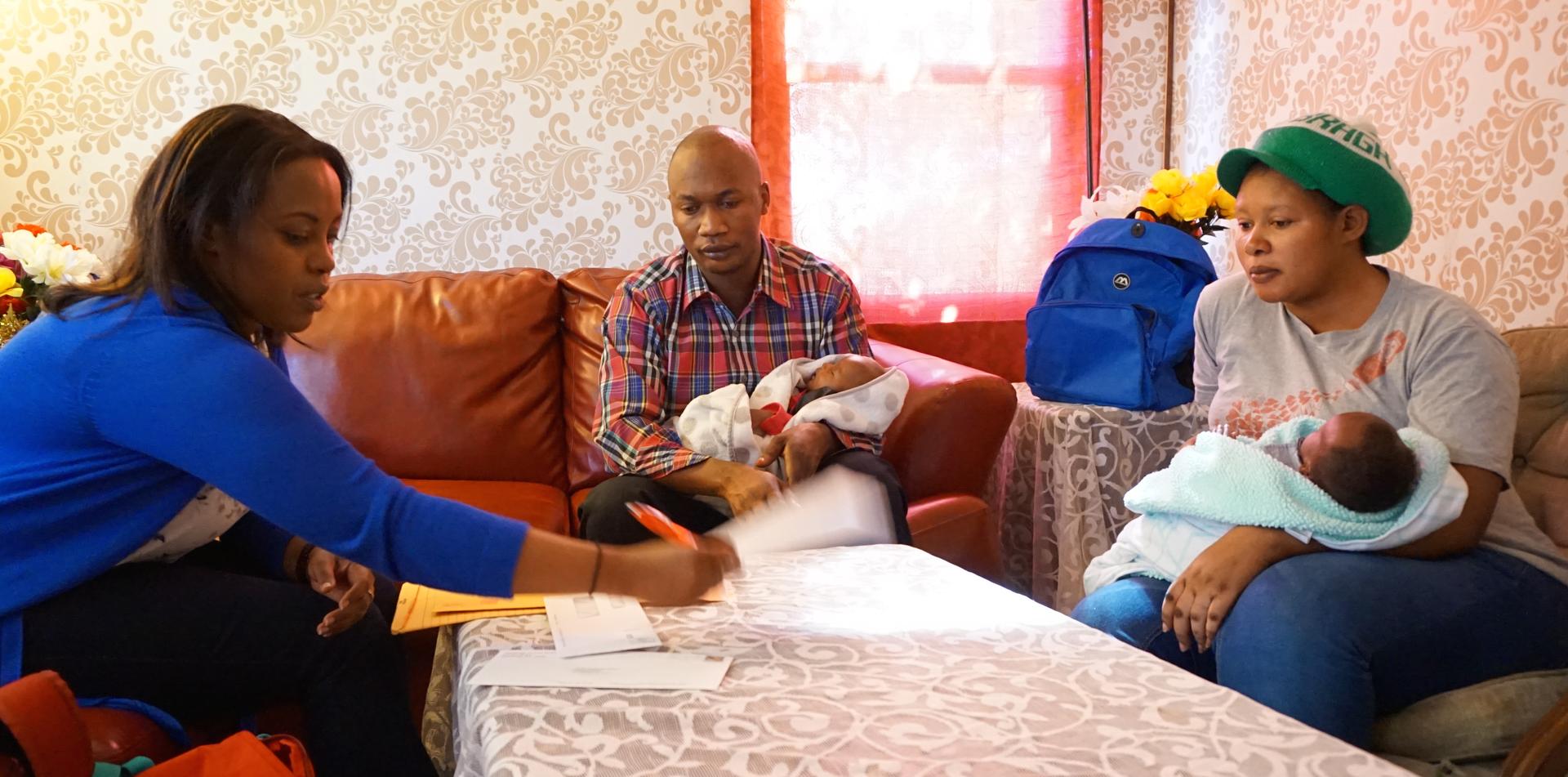Residents fled gun violence at a Pittsburgh public housing project. But refugees are still moving in.
Samuel Bomera, in the center, and Mpanzu Barugire, on the right, came to the US as refugees from the Democratic Republic of Congo. They hold their newborn twins as they meet with a social worker, Viola Byegata, at their new home in Northview Heights, a public housing project in Pittsburgh, on Oct. 4, 2017.
When Bill Gandy was growing up in Northview Heights in the 1970s and 80s, no one had to show identification to get in. But now there are armed guards and 200 security cameras dotted around this sprawling, isolated public housing project run by the Pittsburgh City Housing Authority. Everyone who enters has to show ID, every time.
"It just feels like a prison system to have a checkpoint in front of a neighborhood," Gandy says. "That's already a bad start, to tell you the truth. It's like going into a military camp."
But Gandy, who moved out in 1990, understands why security is so tight. Northview Heights is a much more dangerous place than when he was growing up there decades ago.
This summer, he organized a reunion for people like him. Friends who hadn't seen each other in years traveled from Georgia, Michigan and from their new homes right up the street. They remembered happier times at Northview Heights, when there were marching bands and clubs — and gun violence was not a concern.
But things changed, they say, when Pittsburgh's steel industry crashed in the 1980s and the crack cocaine epidemic took hold in the 1990s. Everyone knew someone who was killed. At the reunion, there was a memorial, a poster-board with dozens of pictures of those lost to gun violence. The woman who organized it, Catrina Herring, grew up in Northview Heights.
"When we were growing up, we had drill team, we had photography class, we played at the recreation center," she says. "We [could] sit outside of our house 'til four o'clock in the morning with the doors open."
Then, in the 90s, her cousin Montell Herring was killed. She left Northview Heights shortly after.
"I have three children … and I thank God that I got them out of the community," she says.
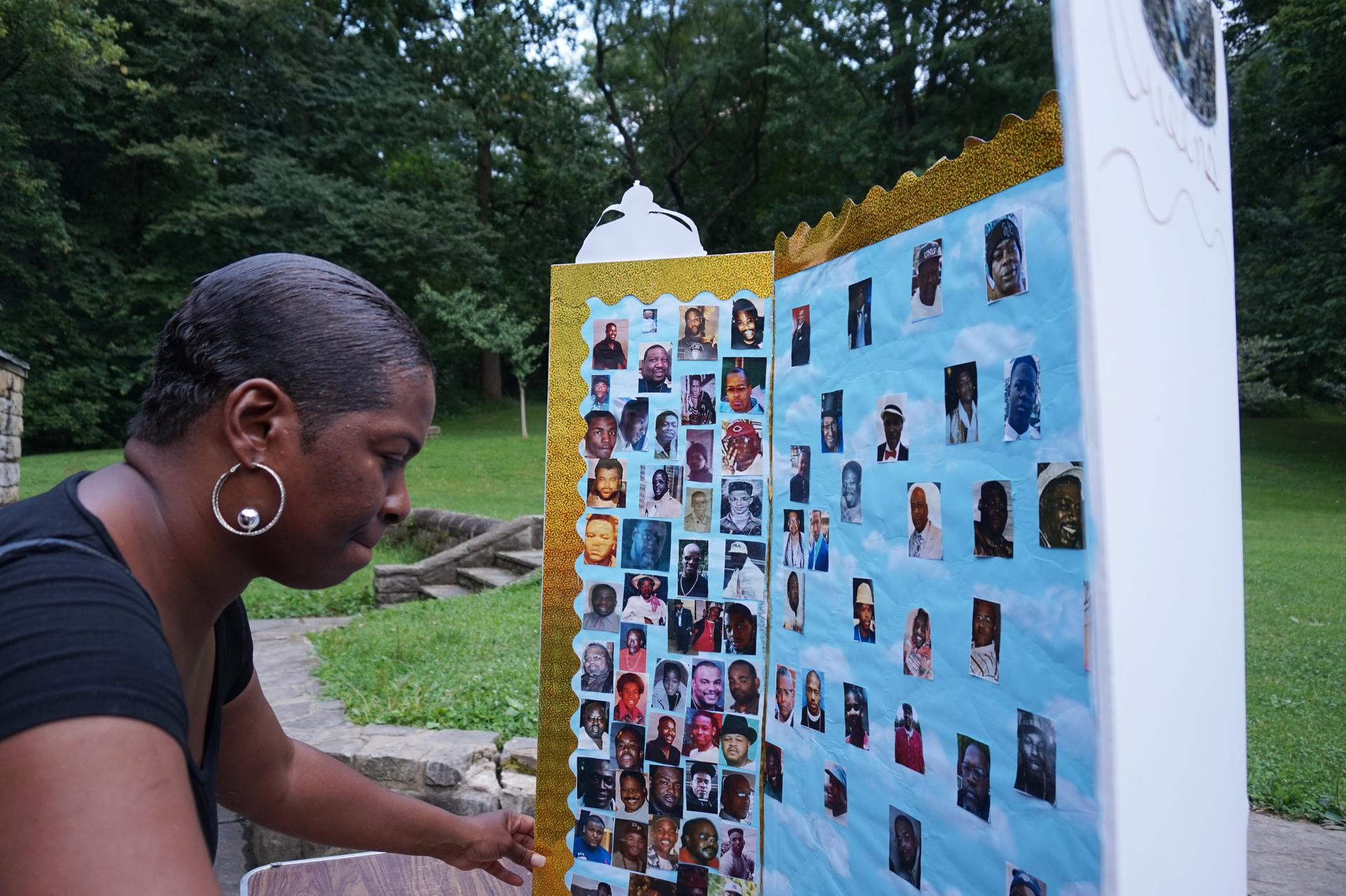
Around 1,600 people still live in Northview Heights. Gandy, who visits regularly, was surprised a few years ago when he started seeing some of the newer residents: people who came to the US as refugees fleeing war zones in several African countries. He worries about them trying to start their new lives in his old neighborhood.
"I don't think that's an environment that you would want to bring somebody new into this country in," he says. "After they've already left a traumatic situation, you're bringing them back to another area where you can experience trauma."
One of those newcomers is Samuel Bomera. A few months after he moved into the housing project, in August 2017, there was a shootout between different groups of teenagers. There were no deaths, but it rattled everyone at Northview Heights.
"It was like being back in Congo, hearing the gunshots," Bomera says. "And I think, 'Am I back in a war zone, or am I in a safe country?' That's when I kind of regret being here."
Bomera came from the Democratic Republic of Congo. He and his family moved to Pittsburgh in 2016 after years of living in refugee camps in Uganda. A resettlement agency, Jewish Family and Community Services of Pittsburgh, found them an apartment on a bus line so they would be able to get to work and appointments without a car. Federal funds from the State Department and Office of Refugee Resettlement that are distributed by the agency paid their $900 per month rent for the first few months. Jewish Family and Community Services paid for a few more months with money the organization receives from grants and donations.
"After that, the family was trying to pay but you could tell it was a struggle," says Violeta Byegata, a social worker with Jewish Family and Community Services. "We don't really have that kind of funding to sustain them forever. So that's how he ended up coming here."
Also: For refugees in Seattle, rising rents mean the search for home isn't over
At Northview Heights, where every household pays a third of its income in rent, Bomera's rent now is only $500 a month. Utilities are included. He pays it with wages he earns at a chocolate factory.
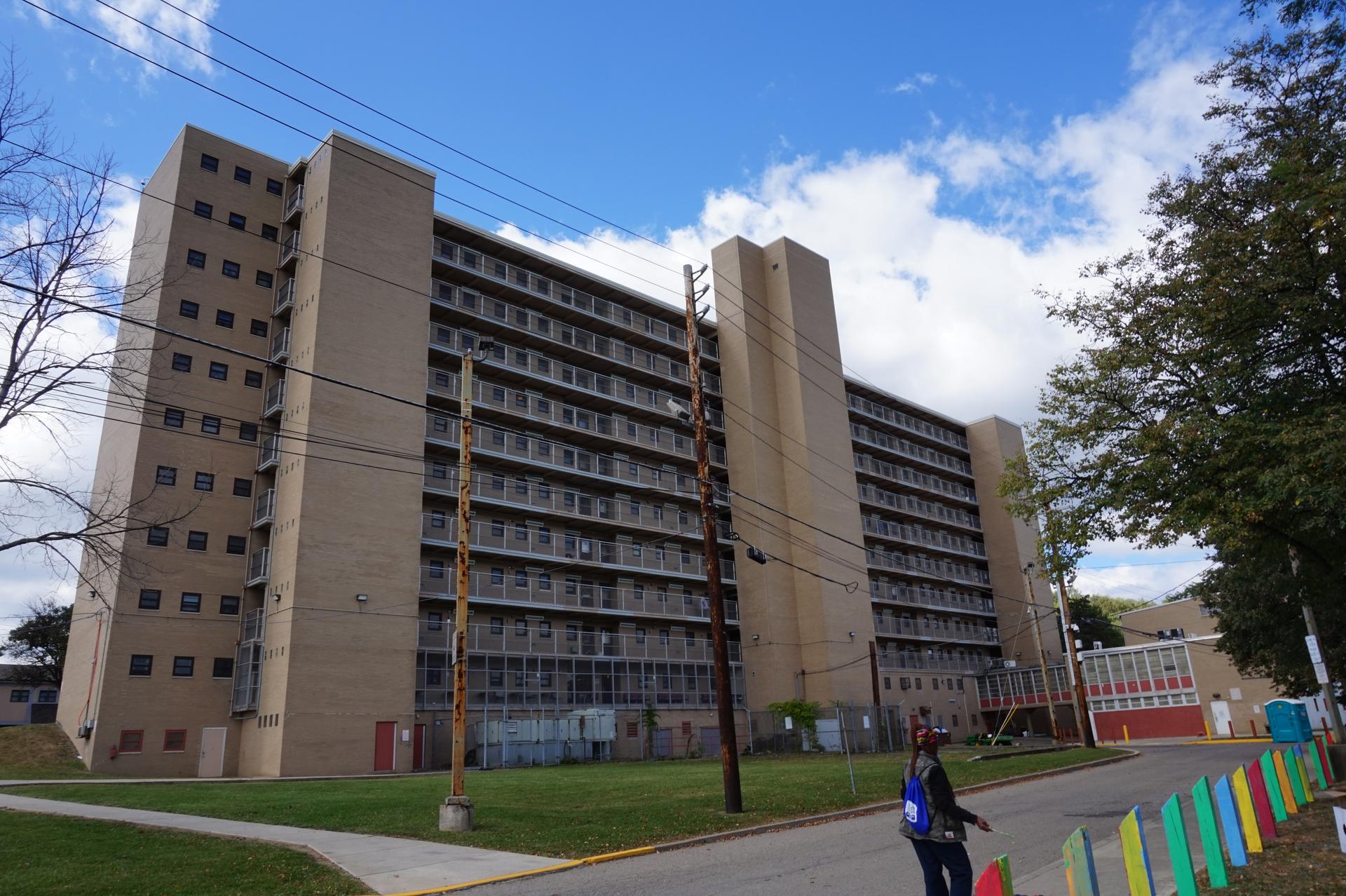
"You have to live here because this is what you can afford," Bomera says. "But if I have money, I want my family, my children to be raised in a comfortable place in a beautiful house. But here, you don't know what's going to happen. I see this as a survival place for the time being, when I don't have any other choice."
For many years, people who lived in Northview Heights were mostly African American. The population in the units declined during the violence of the 1990s, leaving apartments vacant. Then, about a decade ago, Pittsburgh's economy rebounded and housing costs started rising, displacing people from other neighborhoods.
"Starting in about 2007 there was a period of more folks moving into the Pittsburgh region than moving out," says Christopher Briem, an economist at the University of Pittsburgh. "That certainly had a big impact on the housing markets because especially as you get more people moving in, they tend to be younger, tend to be professional."
A few Somali families who had arrived as refugees were priced out of their apartments and moved into Northview Heights. Other refugee families from the Democratic Republic of Congo and Burundi followed. Soon, the community became what some people in Pittsburgh — and many who attended the Northview Heights reunion — call "Half-rican," meaning "half African."
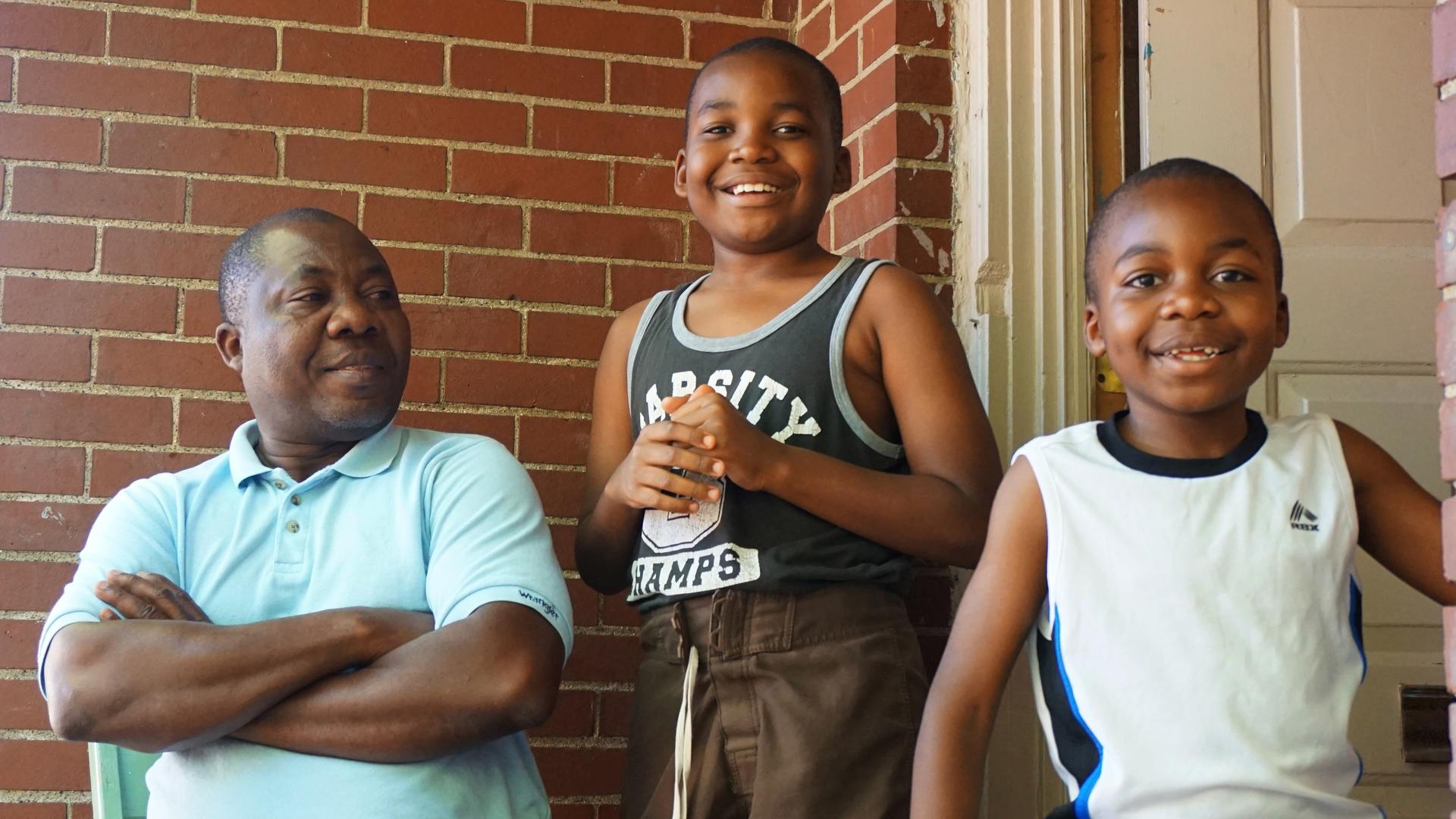
"It's not that they are horrible or places that they could not live in," says Yinka Aganga-Williams, who runs Acculturation for Justice, Access and Peace Outreach (AJAPO), another refugee resettlement agency in Pittsburgh. "I mean, for goodness sake, there are Americans in them."
In fact, some of the newcomers say they are drawn to Northview Heights because the communal life there reminds them of life back home in Africa, and even the refugee camps where they lived for many years. Aweys Mwaliya, 35, says he loves living around other Somali immigrants. He speaks English and has a computer so he's in high demand with his neighbors, helping them navigate life in the US. But the gunshots that so rattled Bomera in August 2017 shook him up too.
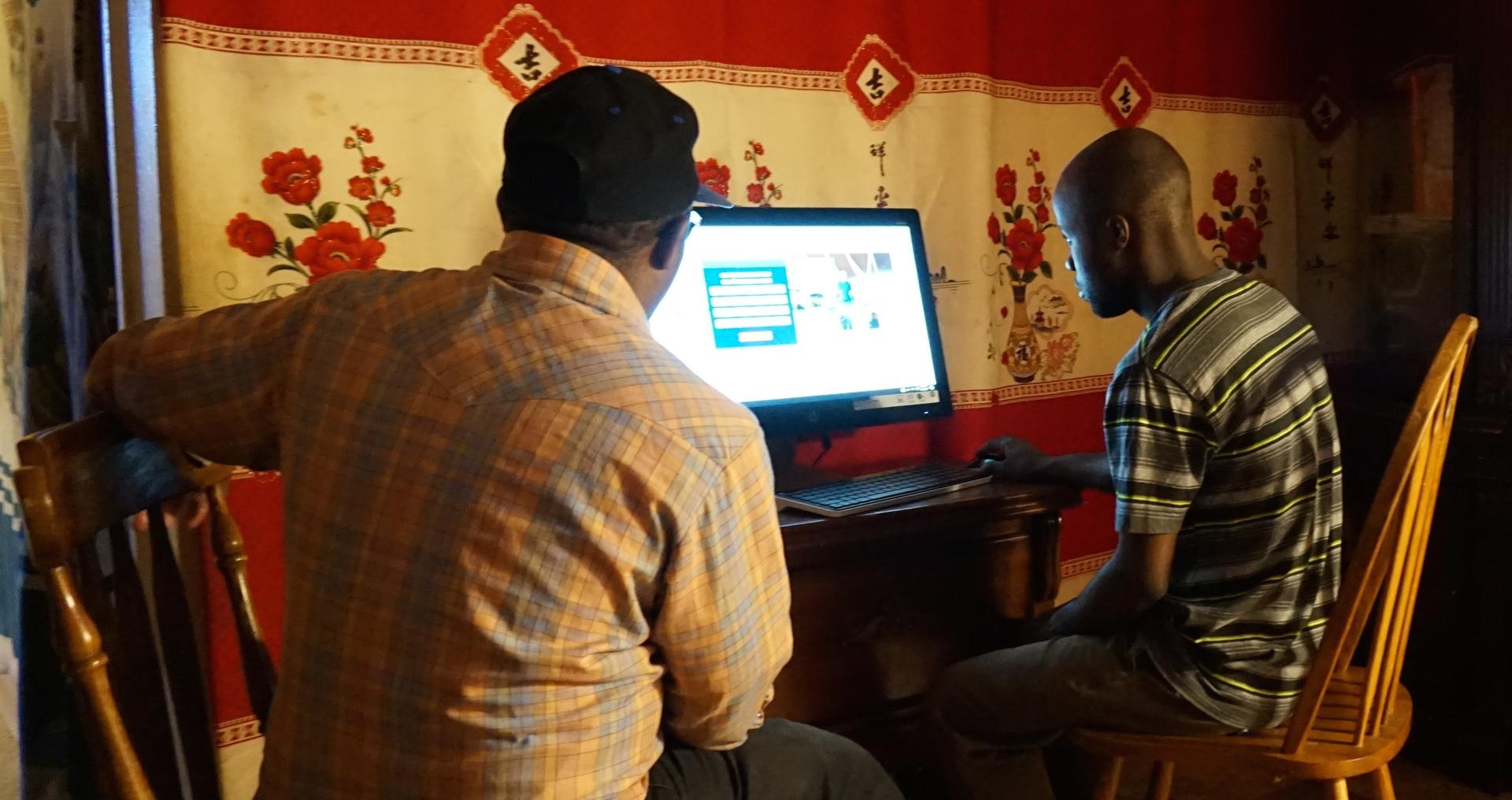
"That shooting — I don't know what the cause is, but it really affected the whole community," he says. "Saying, OK, we again are finding ourselves in the middle of such kind of situation which we were not expecting to happen in the United States."
Keisha Allen has lived in Northview Heights her whole life. And it's been mostly fine. Then, in August 2016, her 26-year-old son, Manly Banks III, was shot dead.
Allen slid into a profound depression. She couldn't work. She couldn't function. The loss of her son gutted her life.
"It was either seek help or keep suffering with a nervous breakdown and keep ending up in mental institutions," she says. "So, I went and sought help. And right now, I'm still getting help."
Allen sees Vanessa Mayers-Snyder, a therapist with the Center for Victims, a nonprofit that helps victims of violent crime. Mayers-Snyder spends at least one day a week in Northview Heights. She sees trauma in most of the people here, she says, and a very specific kind of loss.
"When a person loses a loved one to violence they do grieve, but it's a different type of grief because that person has been ripped away from them," she says.
Allen's pain is still pronounced. Most days, she wears a shirt with her dead son's name and image on the front and the words "Mommy loves you' on the back. Because of all the security cameras at Northview Heights, her son's killer was caught.
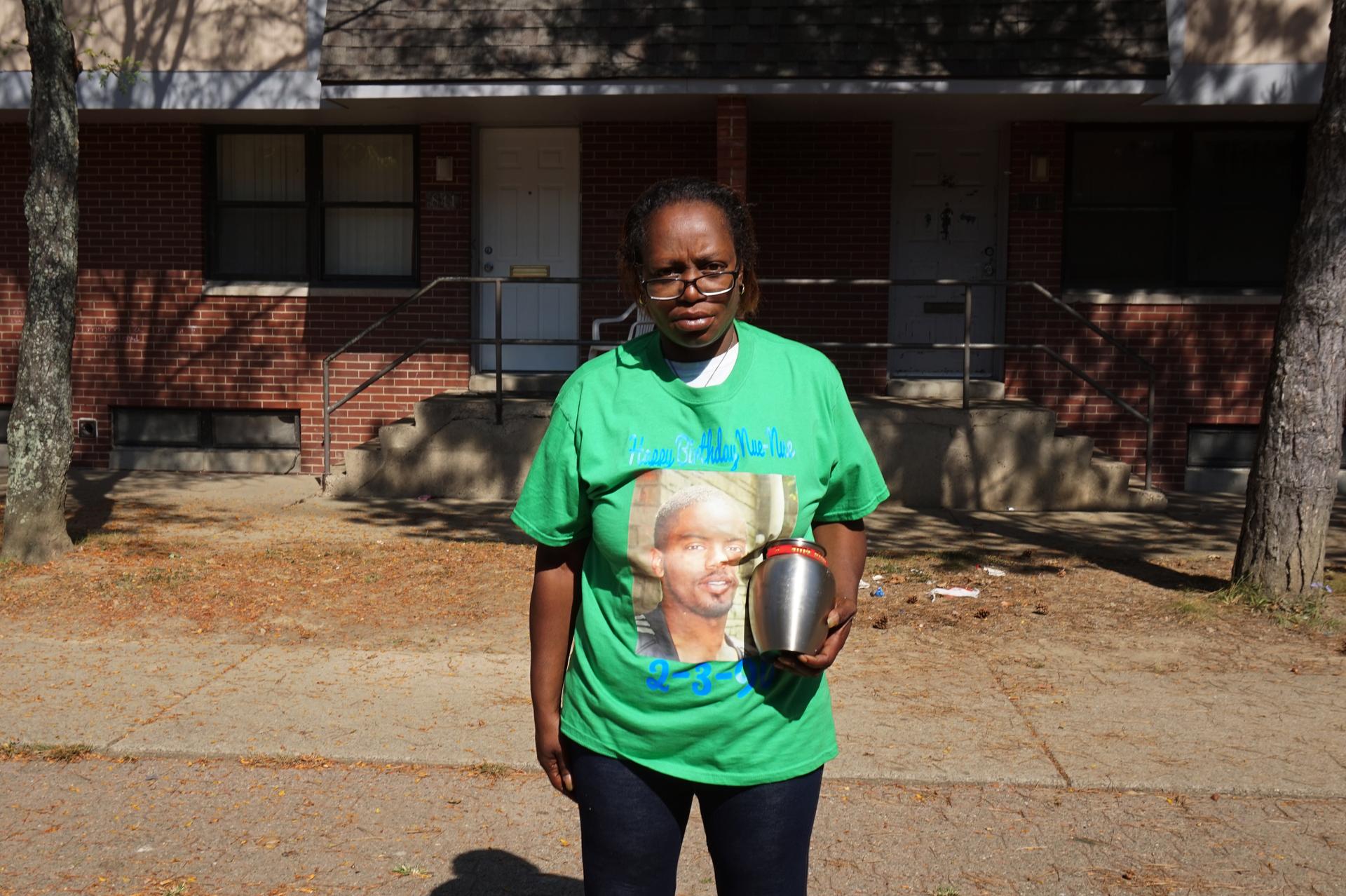
That was 2016. In 2017, there have been plenty of gunshots, but just one homicide at Northview Heights. It happened a few doors down from where Fatuma Muya lives. Like Mwaliya, Muya also came from Somalia. Every time she or her husband or children leave their house, they walk by the spot where a 16-year-old boy, Derrick Brown, was killed this past February. For Muya, it feels the same way it did decades ago, at the start of the civil war in Somalia.
"We just think we [are] in a time of 1991 and Somalia," she says, "because, the same situation was happening when the war started. This is the way it started. Like, a little shooting here and there, and then it became a big war."
Muya also sought help to improve her mental health. She sees a psychologist, Cathy Sigmund, who has a private practice and is also a chaplain with a nearby church. Sigmund works with people who have violence-triggered trauma. Most of her work is talk therapy, but she says the biggest thing she can do for people is just being there and helping them with all the other problems in their lives.
Sigmund started coming to Northview Heights in the 1990s, when the gun violence was at its peak but no one outside the housing project seemed to care.
"When it came to impoverished, marginalized African American communities, there were no responses. At least not to the extent [needed]. And we were having murder after murder," she says.
Crime has gone down since, but the trauma remains. Former US Attorney David Hickton got to know Northview Heights when he was prosecuting gang members there between 2010 and 2016. The one thing that really stays with him, he says, is how much trauma existed in long-time members of the community.
"What if at night you went to bed and you slept in your bathtub because you are afraid that a stray bullet would kill you or your child?" he says. "What impact would that have on you? Would it raise your blood pressure, would it make you more anxious? Would it make you depressed? And the answer is, of course it does."
Research has shown that exposure to prolonged traumatic experience, like living through a war, can change the way our brains are wired. It's an evolutionary response to stress, according to Garth Graham, a former Deputy Assistant Secretary in the US Department of Health and Human Services who has focused on urban health issues.
"As people go through life and they get repeatedly exposed to injury, then what they do is they continue to kind of store these experiences and that's where you see a lot of young and older folks who have been repeatedly exposed to violence develop all these amazing signs of PTSD," he says.
Researchers have compared the kind of behavioral response to violence seen in some urban communities to the responses of war veterans. They both experience symptoms that accompany PTSD, such as repetitive thinking and intrusive thoughts.
"We see a lot of that within urban communities, as people are repeatedly exposed to violence," Graham says. "Again, like you would in a war-torn nation."
For someone like 31-year-old Muya, who lived through a war as a civilian and then moved to a community with high levels of trauma from violence, all sorts of things can trigger depression.
"Because we are people who have seen or faced a lot of situations, we just think one day it will be bigger. That's what we think is making us depressed," she says.
Like Allen, who lost her son in 2016, Muya continues treatment for depression. She's been hospitalized for depression three times — and once more for stomach pains brought on by anxiety — and keeps going to therapy.
"They give me some medicine, they kept me at the hospital. I started having counseling here and there. But right now, I'm a little bit better," she says.
Her big worry now is not for herself, but her children. She doesn't want them to start out their lives with the kind of trauma she experienced back in Somalia, or to expose them to the kind of violence she witnessed as a child.
"I don't think it's a good idea to make your children grow up in here," she says. "I don't want to lose my children in the future. I don't want to lose my children's life in the future."
For now, she keeps her front door locked and her kids inside. Sometimes she sees young men walking around, African or African American, and from the back they look like the six brothers she lost during the war in Somalia in the early 1990s. That makes her cry and brings about her depression. Therapy alone isn't going to fix it, she says. She's hoping that she and her husband can put a bid in on a house and move.
But that will take money and time.
This report was done with the support of a fellowship from the Dart Center for Journalism and Trauma at Columbia Journalism School.
We’d love to hear your thoughts on The World. Please take our 5-min. survey.
